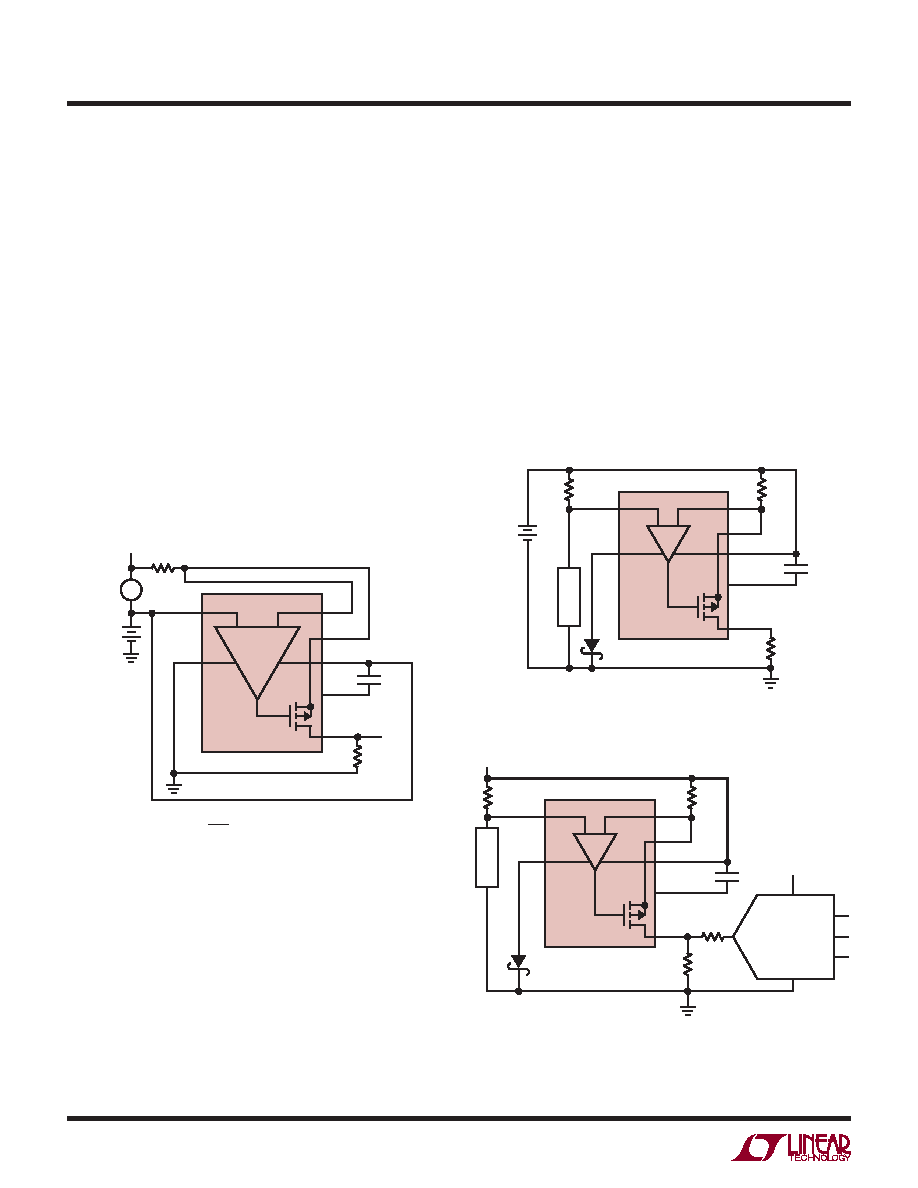- 您現(xiàn)在的位置:買賣IC網(wǎng) > PDF目錄3285 > LTC6102HDD-1#TRPBF (Linear Technology)IC AMP CURRENT SENSE 8-DFN PDF資料下載
參數(shù)資料
| 型號(hào): | LTC6102HDD-1#TRPBF |
| 廠商: | Linear Technology |
| 文件頁(yè)數(shù): | 10/26頁(yè) |
| 文件大?。?/td> | 0K |
| 描述: | IC AMP CURRENT SENSE 8-DFN |
| 標(biāo)準(zhǔn)包裝: | 2,500 |
| 放大器類型: | 電流檢測(cè) |
| 電路數(shù): | 1 |
| 增益帶寬積: | 200kHz |
| 電流 - 輸入偏壓: | 60pA |
| 電壓 - 輸入偏移: | 3µV |
| 電流 - 電源: | 420µA |
| 電流 - 輸出 / 通道: | 1mA |
| 電壓 - 電源,單路/雙路(±): | 4 V ~ 60 V |
| 工作溫度: | -40°C ~ 125°C |
| 安裝類型: | 表面貼裝 |
| 封裝/外殼: | 8-WFDFN 裸露焊盤 |
| 供應(yīng)商設(shè)備封裝: | 8-DFN-EP(3x3) |
| 包裝: | 帶卷 (TR) |
第1頁(yè)第2頁(yè)第3頁(yè)第4頁(yè)第5頁(yè)第6頁(yè)第7頁(yè)第8頁(yè)第9頁(yè)當(dāng)前第10頁(yè)第11頁(yè)第12頁(yè)第13頁(yè)第14頁(yè)第15頁(yè)第16頁(yè)第17頁(yè)第18頁(yè)第19頁(yè)第20頁(yè)第21頁(yè)第22頁(yè)第23頁(yè)第24頁(yè)第25頁(yè)第26頁(yè)

LTC6102
LTC6102-1/LTC6102HV
18
6102fd
Figure 10. Additional Resistor R3 Protects
Output During Supply Reversal
APPLICATIONS INFORMATION
6102 F10
LTC6102
R2
4.99k
D1
R1
100Ω
RSENSE
–
+
V+
V–
OUT
+IN
VBATT
R3
1k
–INF
–INS
VREG
0.1μF
L
O
A
D
ADC
the allowed output current. The gain is still controlled by
ROUT/RIN, so either gain or attenuation may be applied to
the input signal as it is translated to the output. Finally,
the input may be a voltage source rather than a sense
resistor, as shown in Figure 8. This circuit allows the
translation of a wide variety of input signals across the
entire supply range of the LTC6102 with only a tiny offset
error while retaining simple gain control set by ROUT/RIN.
Again, very large voltages may be sensed as long as RIN
is chosen so that IOUT does not exceed the allowed output
current. For example, VIN may be as large as 1V with RIN =
1k, or as large as 10V with RIN = 10k. For a 10V maximum
input and a 5V maximum output, RIN = 10k and ROUT = 5k
will allow the LTC6102HV to translate VIN to VOUT with a
common mode voltage of up to 100V. For the case where
a large input resistor is used, a similar resistor in series
with +IN will reduce error due to input bias current.
Figure 8. Voltage Level-Shift Circuit
Figure 9. Schottky Prevents Damage During Supply Reversal
–INF
–INS
LTC6102
ROUT
VOUT
6102 F08
RIN
VIN
VCM
V+
V–
OUT
+IN
VREG
0.1μF
–
+
VOUT = VIN
ROUT
RIN
6102 F09
LTC6102
R2
4.99k
D1
R1
100Ω
VBATT
RSENSE
V+
V–
–INF
OUT
–INS
+IN
VREG
0.1μF
L
O
A
D
–
+
Reverse Supply Current
Some applications may be tested with reverse-polarity
supplies due to an expectation of this type of fault during
operation. The LTC6102 is not protected internally from
external reversal of supply polarity. To prevent damage
that may occur during this condition, a Schottky diode
should be added in series with V– (Figure 9). This will
limit the reverse current through the LTC6102. Note that
this diode will limit the low voltage performance of the
LTC6102 by effectively reducing the supply voltage to the
part by VD.
In addition, if the output of the LTC6102 is wired to a device
that will effectively short it to high voltage (such as through
an ESD protection clamp) during a reverse supply condi-
tion, the LTC6102’s output should be connected through
a resistor or Schottky diode (Figure 10).
Response Time
The LTC6102 is designed to exhibit fast response to inputs
for the purpose of circuit protection or signal transmission.
This response time will be affected by the external circuit
in two ways, delay and speed.
相關(guān)PDF資料 |
PDF描述 |
|---|---|
| VA100014A300DL | VARISTOR TVS 14VDC 40A AXIAL |
| 2-535541-0 | CONN RCPT 22POS VERT .100 GOLD |
| VA100005A150DL | VARISTOR TVS 5.6VDC 40A AXIAL |
| 1-87987-0 | 10 MODI BDMNT RCPT SR .156CL |
| 1-87985-0 | CONN RCPT 10POS VERT .156 PCB |
相關(guān)代理商/技術(shù)參數(shù) |
參數(shù)描述 |
|---|---|
| LTC6102HDD-PBF | 制造商:LINER 制造商全稱:Linear Technology 功能描述:Precision Zero Drift Current Sense Amplifi er |
| LTC6102HDD-TR | 制造商:LINER 制造商全稱:Linear Technology 功能描述:Precision Zero Drift Current Sense Amplifi er |
| LTC6102HDD-TRPBF | 制造商:LINER 制造商全稱:Linear Technology 功能描述:Precision Zero Drift Current Sense Amplifi er |
| LTC6102HMS#PBF | 制造商:Linear Technology 功能描述:AMP CURRENT SENSE PRECISION SMD |
| LTC6102HMS8 | 制造商:Linear Technology 功能描述:SP Amp Current Sense Amp Single 60V 8-Pin MSOP |
發(fā)布緊急采購(gòu),3分鐘左右您將得到回復(fù)。